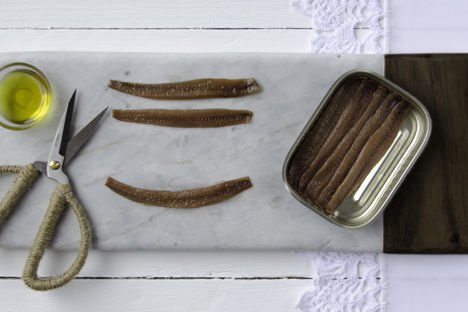
Ingredient focus: the Cantabrian anchovy
The Cantabrian town of Santoña is famed for its salted anchovies. We take a visit there to find out more.
Ingredient focus: the Cantabrian anchovy
The Cantabrian town of Santoña is famed for its salted anchovies. We take a visit there to find out more.
When you approach the small town of Santoña from the east, leaving behind the heaving resort of Laredo (where a 5km beach is packed with inhabitants from nearby Bilbao) the first thing you notice is that it appears to be a quaint old town full of traditional buildings. The salt marsh that surrounds Santoña is a natural park that is well known as a seabird habitat. Santoñans are able to sit outside for their aperitivos, stare across the bay at built-up Laredo and live their lives without bother from the hordes of city tourists that visit other seaside towns.
What makes Santoña famous is anchovies. Santoña is one of the biggest processors of preserved anchovies in Spain, and the products are widely considered to be the best in the world.
The industry is said to have been started by an Italian who had traveled to the region in search of a new source of anchovies and found the ones fished off the coast of Santoña to be better than anywhere else. He decided to stay in Santoña and set up a business (today under the brand name Doña Dolores) for filleting and canning the salted anchovies there rather than doing the job back in Italy. With that, the town’s fish canning industry was born. The superb raw material combined with excellent Spanish olive oil created a sublime product and Cantabrian anchovies are still considered the best in the world.
At first, the anchovy fillets were covered in butter but that was soon replaced by Spain’s abundant olive oil. Other than that, the process of salting, filleting and canning has hardly changed and now Santoña has an industrial estate near its port dedicated to the anchovy processing industry.
One of the smaller canneries is El Capricho owned by brothers César and Jose-Luis Iglesias, ‘we’re not related to Julio or Enrique,’ beams César, ‘but Julio’s Dad used to buy our anchovies and would call us ‘cousins’ when he phoned to order.’
El Capricho was opened more than thirty-three years ago by the Iglesias’ brothers’ father and uncle. An electrician and a builder by trade, they regularly gave presents of anchovies to clients and were lamenting their decreasing quality. ‘One Christmas,’ says Jose-Luis, ‘they decided they were going to go into the business themselves and sell the best quality anchovies. It was one of those conversations that everyone has after a big meal and a lot of wine, but a few months later my uncle went to see my dad with a serious business plan and they set up El Capricho.’
The senior Iglesias brothers learned all about the anchovy process in Santoña, and when they finally started producing anchovies, their price point was three times that of any other competitor. ‘The thing we have always done in this company is try to do the highest quality and then we look at what price we sell at. We are a very small company and produce relatively little so what we do make is always for the top end of the market,’ says César.
Directly across the road in the industrial estate is the far larger El Consorcio, which has been open since 1950. One of the largest processors, El Consorcio’s anchovies are the most popular brand in Spain, selling anchovies in various categories. ‘Our anchovies are something like our ham or wine in Spain,’ says CEO Ignacio Corral, ‘when you have a special occasion you have the best wine, the best ham and the best anchovies. You want ones that are plump and have been salted for much longer, sometimes as long as three years before they are hand filleted and cleaned and placed in a tin. But anchovies are also for every day, you don’t want to spend the same amount of money on ones you are going to put in a pasta sauce or a quickly made cheese sandwich, and we make a broad range, so that people have a choice.’
The height of the fresh anchovy fishing season in Santoña is between March and July, which coincides with the time the Italian merchants originally came looking, and the Iglesias brothers only buy anchovies during that time. El Consorcio buys from Santoña and from across the globe when necessary. The sheer quality of the Cantabrian anchovies means these are destined to be the very top-of-the-range, premium product to be savoured on their own, whereas any imported anchovies will be sold as a more everyday product suitable for use in cooking.
The fresh anchovies are immediately salted to stiffen them. Next, the heads are pulled off and they are washed. Finally, they are placed in a plastic barrel with salt and cured for a minimum of nine months before they can be sold as preserved anchovies.
‘This to me just tastes of bocarte (fresh anchovy) and salt,’ says César Iglesias, dipping his finger into the liquid that has risen to the surface of an eight-month-old barrel, ‘you really need it to be in salt for longer to get that proper anchovy taste.’
After anything from nine months to three years the anchovies are de-salted and cleaned, which includes removing all the bones, then dried and placed in tins or jars covered in oil (either sunflower or olive) and then sealed. This process is still carried out entirely by hand.
The result is a range of anchovies to suit all pockets and purposes, for example, they can be eaten as a snack with some olives, added to a lamb stew for a weekday dinner, or served as a top-of-the-range ingredient with your best bread and that bottle of special wine you’ve been saving.

